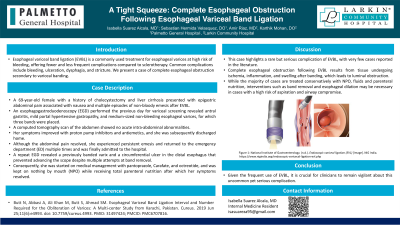Sunday Poster Session
Category: Esophagus
P0599 - A Tight Squeeze: Complete Esophageal Obstruction Following Esophageal Variceal Band Ligation
Sunday, October 27, 2024
3:30 PM - 7:00 PM ET
Location: Exhibit Hall E

Has Audio

Isabella Suarez Alcala, MD
Palmetto General Hospital
Hialeah, FL
Presenting Author(s)
Isabella Suarez Alcala, MD1, Sebastian Hermida Velasquez, DO1, Amir Riaz, MD2, Karthik Mohan, DO3
1Palmetto General Hospital, Hialeah, FL; 2Larkin Community Hospital, South Miami, FL; 3Larkin Community Hospital, Hialeah, FL
Introduction: Esophageal variceal band ligation (EVBL) is a commonly used treatment for esophageal varices at high risk of bleeding, offering fewer and less frequent complications compared to sclerotherapy. Common complications include bleeding, ulceration, dysphagia, and stricture. We present a case of complete esophageal obstruction secondary to variceal banding.
Case Description/Methods: A 69-year-old female with a medical history of cholecystectomy and liver cirrhosis presented with epigastric abdominal pain associated with nausea and multiple episodes of non-bloody emesis after EVBL. An esophagogastroduodenoscopy (EGD) performed the previous day for variceal screening revealed antral gastritis, mild portal hypertensive gastropathy, and medium-sized non-bleeding esophageal varices, for which three bands were placed. A computed tomography scan of the abdomen showed no acute intra-abdominal abnormalities. Her symptoms improved with proton pump inhibitors and antiemetics, and she was subsequently discharged home. Although the abdominal pain resolved, she experienced persistent emesis and returned to the emergency department (ED) the next day. After showing improvement with medical management and tolerating a diet, she was discharged with an acid blocker and antiemetics. However, due to intractable non-bloody emesis and inability to tolerate food, she returned to the ED two days later and was admitted to the hospital. A repeat EGD revealed a previously banded varix and a circumferential ulcer in the distal esophagus that prevented advancing the scope despite attempts at band removal. Consequently, she was started on pantoprazole, Carafate, and octreotide, and was kept on nothing by mouth (NPO) while receiving total parenteral nutrition. After maintaining bowel rest for two days, she was started on a clear liquid diet, which she tolerated, and was subsequently discharged.
Discussion: This case highlights a rare but serious complication of EVBL, with very few cases reported in the literature. Complete esophageal obstruction following EVBL results from tissue undergoing ischemia, inflammation, and swelling after banding, which leads to luminal obstruction. While the majority of cases are treated conservatively with NPO, fluids and parenteral nutrition, interventions such as band removal and esophageal dilation may be necessary in cases with a high risk of aspiration and airway compromise. Given the frequent use of EVBL, it is crucial for clinicians to remain vigilant about this uncommon yet serious complication.
Disclosures:
Isabella Suarez Alcala, MD1, Sebastian Hermida Velasquez, DO1, Amir Riaz, MD2, Karthik Mohan, DO3. P0599 - A Tight Squeeze: Complete Esophageal Obstruction Following Esophageal Variceal Band Ligation, ACG 2024 Annual Scientific Meeting Abstracts. Philadelphia, PA: American College of Gastroenterology.
1Palmetto General Hospital, Hialeah, FL; 2Larkin Community Hospital, South Miami, FL; 3Larkin Community Hospital, Hialeah, FL
Introduction: Esophageal variceal band ligation (EVBL) is a commonly used treatment for esophageal varices at high risk of bleeding, offering fewer and less frequent complications compared to sclerotherapy. Common complications include bleeding, ulceration, dysphagia, and stricture. We present a case of complete esophageal obstruction secondary to variceal banding.
Case Description/Methods: A 69-year-old female with a medical history of cholecystectomy and liver cirrhosis presented with epigastric abdominal pain associated with nausea and multiple episodes of non-bloody emesis after EVBL. An esophagogastroduodenoscopy (EGD) performed the previous day for variceal screening revealed antral gastritis, mild portal hypertensive gastropathy, and medium-sized non-bleeding esophageal varices, for which three bands were placed. A computed tomography scan of the abdomen showed no acute intra-abdominal abnormalities. Her symptoms improved with proton pump inhibitors and antiemetics, and she was subsequently discharged home. Although the abdominal pain resolved, she experienced persistent emesis and returned to the emergency department (ED) the next day. After showing improvement with medical management and tolerating a diet, she was discharged with an acid blocker and antiemetics. However, due to intractable non-bloody emesis and inability to tolerate food, she returned to the ED two days later and was admitted to the hospital. A repeat EGD revealed a previously banded varix and a circumferential ulcer in the distal esophagus that prevented advancing the scope despite attempts at band removal. Consequently, she was started on pantoprazole, Carafate, and octreotide, and was kept on nothing by mouth (NPO) while receiving total parenteral nutrition. After maintaining bowel rest for two days, she was started on a clear liquid diet, which she tolerated, and was subsequently discharged.
Discussion: This case highlights a rare but serious complication of EVBL, with very few cases reported in the literature. Complete esophageal obstruction following EVBL results from tissue undergoing ischemia, inflammation, and swelling after banding, which leads to luminal obstruction. While the majority of cases are treated conservatively with NPO, fluids and parenteral nutrition, interventions such as band removal and esophageal dilation may be necessary in cases with a high risk of aspiration and airway compromise. Given the frequent use of EVBL, it is crucial for clinicians to remain vigilant about this uncommon yet serious complication.
Disclosures:
Isabella Suarez Alcala indicated no relevant financial relationships.
Sebastian Hermida Velasquez indicated no relevant financial relationships.
Amir Riaz indicated no relevant financial relationships.
Karthik Mohan indicated no relevant financial relationships.
Isabella Suarez Alcala, MD1, Sebastian Hermida Velasquez, DO1, Amir Riaz, MD2, Karthik Mohan, DO3. P0599 - A Tight Squeeze: Complete Esophageal Obstruction Following Esophageal Variceal Band Ligation, ACG 2024 Annual Scientific Meeting Abstracts. Philadelphia, PA: American College of Gastroenterology.

